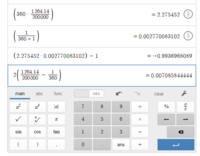NewtonsEye
New member
- Joined
- Apr 8, 2021
- Messages
- 2
Hello All,
Attempting to use Newton-Raphson method to determine APR. According to my workbook, it says:
The first guess for using Newton-Raphson method to solve for i must be to the right of the critical point, where the curve has a derivative of zero (any estimate to the left of the critical point results in a false solution of 0.000%)."
That critical point occurs at: ilow = (Nx/P)(1/(N + 1)) – 1
I CANNOT PRODUCE THE 0.002279791 ANSWER. I ALWAYS GET -0.9936968089 (see calculator print below). NOT SURE IF THIS FORMULA IS WRONG OR PERHAPS MY SETUP???
A useful upper bound (although higher estimates still converge), is the case where the interest is not compounded: ihigh = 2(x/P - 1/N) - WORKS FINE
The equation in this case for finding successive estimates for i is:
i' = i - (P[0]*i - x(1 - R - N) / (P[0] – Nx / R(N + 1))
Or
i' = x(RN - 1 - Ni/R) / (P[0] *R^N – Nx/R) - ALSO CANNOT DUPLICATE THE RESULTS SHOWN FOR i1-i4.
Example:
Use the following to solve for i:
P = $200,000.00
x = $1,264.14
N = 360 (months)
R = 1 + i
V = 1/R (periodic discount factor)
The theoretical low is 0.002279791 (APR = 2.736%) - I GET -0.993696808
The theoretical high is 0.0070858441 (APR = 8.503%) - WORKS FINE
Make the theoretical high as the first guess, and continue to refine i using the Newton-Raphson derived equation for i' until it converges:
i0 = 0.007085844 (APR = 8.503%)
i1 = 0.005550004 (APR = 6.660%)
i2 = 0.005418138 (APR = 6.502%)
i3 = 0.005416692 (APR = 6.500%)
i4 = 0.005416692 (APR = 6.500%)
Since i4 = i3, we have converged on the non-zero root for the equation, and the correct APR is 6.500%.
In the context of solving for the periodic interest rate i, we used the notation i4 to represent the result of fourth iteration of the Newton-Raphson method.

Any insights would be much appreciated!
Newt
Attempting to use Newton-Raphson method to determine APR. According to my workbook, it says:
The first guess for using Newton-Raphson method to solve for i must be to the right of the critical point, where the curve has a derivative of zero (any estimate to the left of the critical point results in a false solution of 0.000%)."
That critical point occurs at: ilow = (Nx/P)(1/(N + 1)) – 1
I CANNOT PRODUCE THE 0.002279791 ANSWER. I ALWAYS GET -0.9936968089 (see calculator print below). NOT SURE IF THIS FORMULA IS WRONG OR PERHAPS MY SETUP???
A useful upper bound (although higher estimates still converge), is the case where the interest is not compounded: ihigh = 2(x/P - 1/N) - WORKS FINE
The equation in this case for finding successive estimates for i is:
i' = i - (P[0]*i - x(1 - R - N) / (P[0] – Nx / R(N + 1))
Or
i' = x(RN - 1 - Ni/R) / (P[0] *R^N – Nx/R) - ALSO CANNOT DUPLICATE THE RESULTS SHOWN FOR i1-i4.
Example:
Use the following to solve for i:
P = $200,000.00
x = $1,264.14
N = 360 (months)
R = 1 + i
V = 1/R (periodic discount factor)
The theoretical low is 0.002279791 (APR = 2.736%) - I GET -0.993696808
The theoretical high is 0.0070858441 (APR = 8.503%) - WORKS FINE
Make the theoretical high as the first guess, and continue to refine i using the Newton-Raphson derived equation for i' until it converges:
i0 = 0.007085844 (APR = 8.503%)
i1 = 0.005550004 (APR = 6.660%)
i2 = 0.005418138 (APR = 6.502%)
i3 = 0.005416692 (APR = 6.500%)
i4 = 0.005416692 (APR = 6.500%)
Since i4 = i3, we have converged on the non-zero root for the equation, and the correct APR is 6.500%.
In the context of solving for the periodic interest rate i, we used the notation i4 to represent the result of fourth iteration of the Newton-Raphson method.

Any insights would be much appreciated!
Newt

